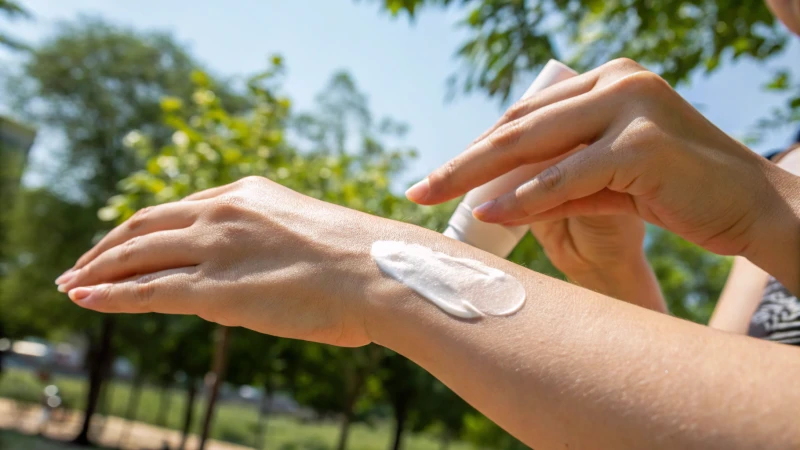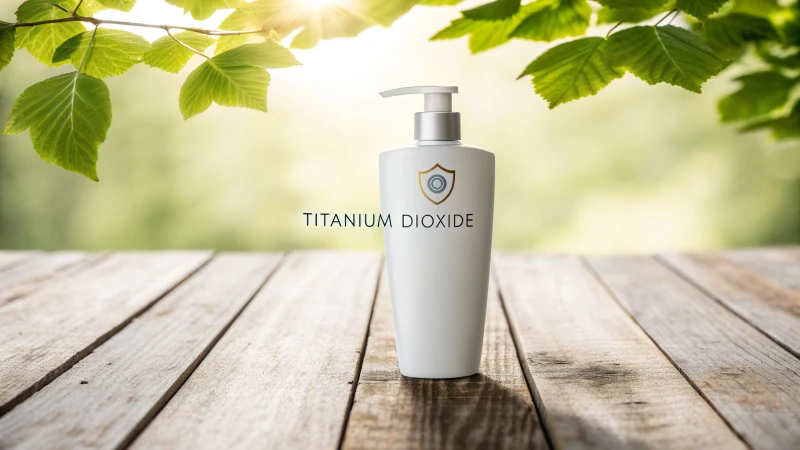
Ever wondered how your foundation provides perfect coverage and also guards your skin against the sun?
Titanium dioxide serves as a common ingredient in foundation makeup. It offers good coverage and acts as a very effective UV filter. The non-nano form stays on the skin's surface. This ensures safety for cosmetic use. It is safe.
Titanium dioxide plays a key role, but many still wonder about its use, safety and advantages in beauty products. This ingredient works wonders for smooth, perfect skin. Imagine standing under the hot midday sun, yet your skin remains very protected and comfortable. That's the special touch of titanium dioxide. Time to explore how this mighty element improves makeup and protects skin. It helps you appear bright and feel confident day by day.
Titanium dioxide provides opacity in foundation.True
It helps achieve the desired coverage by making the foundation less transparent.
Titanium dioxide penetrates the skin in foundation.False
In non-nano form, it remains on the skin's surface, not penetrating it.
What Are the Benefits of Titanium Dioxide in Makeup?
Ever wonder why your favorite makeup protects your skin and looks perfect? Titanium dioxide is the secret ingredient.
Titanium dioxide in makeup gives UV protection, improves coverage and keeps the product stable. This mineral offers opaque coverage. It sits on the skin's surface, not going inside. It is effective. Also, safe.

The Role of Titanium Dioxide in Makeup
I found titanium dioxide (TiO₂) in my makeup and became curious about its many roles. It's like a superhero in a compact. This amazing mineral provides broad spectrum UV protection1, acting as a small mirror, reflecting harmful rays and protecting my skin from damage. I try to be careful with the sun. A memory of a summer with a sunburned nose stays with me. Now, I feel calm knowing my daily products help stop early aging.
| Benefit | Description |
|---|---|
| UV Protection | Reflects UV rays, offering defense against skin damage. |
| Coverage Enhancement | Adds opacity to foundations and concealers for better coverage. |
| Stability | Contributes to the longevity of makeup products, maintaining consistency. |
Types of Titanium Dioxide in Cosmetics
Looking for the best makeup routine, I found out about two kinds of titanium dioxide: non-nano and nano particles. Non-nano ones are like loyal friends; they provide good coverage, perfect for hiding tired eyes. Nano particles are smooth and invisible but still guard the skin.
-
Non-Nano Particles:
- Give thick coverage.
- Stay above the skin, providing safety.
-
Nano Particles:
- Offer clear finishes.
- Stay on skin surface, keeping safety intact.
Safety and Regulatory Aspects
Safety is very important to me, especially in makeup. Worldwide regulatory bodies accept titanium dioxide use in cosmetics within certain limits. The European Union2 has very strict rules to keep both types safe for users. Inhalation might matter in places where they make makeup, but for users, these products are safe.
Considerations for Consumers
Choosing the right makeup might feel hard. My advice? Think about your skin and the finish you want. Non-nano particles suit well if you need full coverage and safety. Look for safety tests or certifications on titanium dioxide3 in your products.
Knowing what's in your makeup really matters; it changes how you pick and use these products. Titanium dioxide remains popular in the industry because it mixes beauty with protection, meeting my need for both safety and style.
Titanium dioxide provides UV protection in makeup.True
Titanium dioxide reflects UV rays, offering defense against skin damage.
Nano particles of titanium dioxide penetrate the skin.False
Nano particles remain on the skin's surface, ensuring safety.
How Does Titanium Dioxide Protect Your Skin?
Did you ever think about why titanium dioxide is always in sunscreens? It works like a hidden shield for your skin against UV rays.
Titanium dioxide serves as a shield on the skin. It reflects and scatters the sun’s UV rays, especially UVB rays. This mineral sunscreen creates a protective layer on the skin's surface. Very importantly, it does not get absorbed. It protects against sunburn. It protects against damage over time.

The Science Behind Titanium Dioxide's Protection
I recall learning about titanium dioxide's power during a sunny beach outing. A friend, who loves skincare, explained its role. This tiny hero sits on the skin, bouncing back UV rays like a mirror. Chemical sunscreens absorb rays instead, but titanium dioxide reflects them. This trait makes it especially good against UVB rays, which cause sunburn and raise skin cancer risks4.
Particle Size and Its Impact
Think of painting a wall with a thick versus a thin brush. The size of titanium dioxide particles affects its effectiveness. In its non-nano form5, larger particles create a visible layer that blocks UV rays well. This form often appears in makeup, giving both coverage and protection.
On the other hand, nano-sized particles are much smaller. They offer transparency while still protecting but stay on the skin's surface, ensuring safety. Just be careful not to inhale them when applying powders.
| Type | Characteristics | Common Use |
|---|---|---|
| Non-Nano | Larger particles, opaque | Makeup, sunscreens |
| Nano | Smaller particles, transparent | Skincare products |
Safety and Environmental Considerations
Titanium dioxide is safe for the skin, but inhaling it in powder form should be avoided. Environmental issues matter too. Washing products with titanium dioxide might pollute water. So many brands work on eco-friendly versions6 to reduce harm.
Comparing Titanium Dioxide with Other Sunscreen Agents
Imagine choosing between two sunscreens: one offers stability and does not irritate - yes, titanium dioxide! The other could break down in sunlight and needs frequent reapplication. Chemical sunscreens may work well but often irritate and degrade in the sun.
| Sunscreen Type | Benefits | Drawbacks |
|---|---|---|
| Titanium Dioxide | Stable, non-irritating | Potential environmental impact |
| Chemical Agents | Absorbs UV rays | May degrade, cause irritation |
Understanding these differences helps me choose wisely for my skincare routine. I trust credible sources7 for learning about sunscreen ingredients to balance their effectiveness with safety.
Titanium dioxide absorbs UV radiation.False
Titanium dioxide reflects and scatters UV rays, not absorbs them.
Nano titanium dioxide penetrates the skin.False
Nano particles remain on the surface, ensuring safety in use.
Is Titanium Dioxide Safe for Daily Use?
Titanium dioxide is a substance found everywhere. You see it at the grocery store and at home in the bathroom mirror. But some people question if this common element is truly safe. Is it?
Titanium dioxide is usually safe for everyday use in beauty products and food. Safety depends on the form and method of use. However, some officials worry about the risks when people swallow or breathe it in.

Understanding Titanium Dioxide
Titanium dioxide (TiO₂) is a mineral found naturally. It is widely used in products like sunscreen and toothpaste to make them white. Its ability to reflect the sun's rays makes it effective in protecting against harmful sunlight.
| Application | Purpose | Form |
|---|---|---|
| Sunscreen | Reflects UV rays | Nano |
| Toothpaste | Whitening agent | Non-nano |
Regulatory Perspectives
Different countries have different rules about using titanium dioxide. In the U.S., the FDA allows it in food and cosmetics, recognizing it as generally safe within specified limits. In contrast, the EU restricts its use in food due to concerns about potential respiratory hazards from inhalation.
- FDA Stance: Usually safe within limits.
- EU Concerns: Avoids food use due to possible breathing risks.
Nano vs. Non-Nano Particles
Tiny particles of titanium dioxide are special. There are two main forms:
- Nano Particles: These are very small and good for clear sunscreens as they don't leave a white film on the skin but rest on the surface without penetrating.
- Non-Nano Particles: Bigger particles used in makeup provide nice coverage by staying on the skin's top layer.
Health Considerations
Breathing titanium dioxide is the main health worry, similar to avoiding flour dust while cooking. Research indicates8 that inhaling it can pose respiratory issues, so reading labels can help avoid exposure. Knowing if products contain nano or non-nano forms can guide your decisions.
Industry Implications
Industries like cosmetics and food need titanium dioxide for balancing safety with product effectiveness—like making a cake without certain ingredients while following local rules and maintaining safety standards. Being updated with research helps them improve their formulations accordingly.
Continuous research ensures that products remain both useful and safe for consumers worldwide. Industry professionals learn from trusted sources9 about chemical safety and health effects, emphasizing the importance of staying informed.
Titanium dioxide is used as a whitening agent in cosmetics.True
It is commonly used for its light-reflecting properties in cosmetics.
The EU allows titanium dioxide in food products.False
The EU prohibits its use in food due to inhalation risks.
How do you choose a foundation with titanium dioxide?
Did you ever find yourself in a cosmetics aisle, feeling overwhelmed by all the foundation choices? Let’s explore how to choose the right one with titanium dioxide for your skin.
Choose a foundation with titanium dioxide by considering your skin type, desired coverage and sun protection needs. Check it is tagged "non-nano" to avoid breathing in risks. Pick a shade that matches your skin tone.

Understanding Titanium Dioxide in Foundations
I recall when I first heard about titanium dioxide in makeup. It felt like finding a precious gem in my beauty routine. Titanium dioxide is a strong ingredient, known for giving good coverage and protection from the sun. Choose products with non-nano titanium dioxide. This type is safer for cosmetics because it is hard to breathe in.
Skin Type Considerations
Knowing your skin type is really important before choosing a foundation. People like me with oily skin find oil-free or mattifying options really helpful. Those with dry skin should try hydrating formulas; they really work. Sensitive skin needs fragrance-free products10 to avoid irritation. I have faced this myself and it's the best choice.
Coverage and Finish
Each day brings different needs for coverage. Here’s a little guide I use:
| Coverage Level | Ideal For | Effect |
|---|---|---|
| Medium | Unexpected blemish days | Reliable |
Medium coverage helps for unexpected blemish days. It is reliable and my regular choice.
Sun Protection Factor (SPF)
Living in constant sunlight makes SPF protection very important. Foundations with titanium dioxide often have SPF. Choose an SPF of 15 or more, especially if you stay outside like me.
Testing Shades
Here’s a tip from my personal trial-and-error: try foundation shades on your jawline and do it in natural light. The perfect shade should mix perfectly with your neck.
Product Labels and Certifications
Search for "non-nano" titanium dioxide on labels because it's safer for cosmetics. Certifications like "Dermatologist Tested" or "Hypoallergenic" provide extra reassurance about a product's safety and quality.
To learn more about picking the perfect foundation for your skin and lifestyle, visit our detailed guide11.
Titanium dioxide provides UV protection in foundations.True
Titanium dioxide is a common sunscreen ingredient offering UV protection.
Non-nano titanium dioxide is unsafe for makeup use.False
Non-nano titanium dioxide is safer for cosmetic use than nano forms.
Conclusion
Titanium dioxide is a key ingredient in foundation, providing UV protection, enhancing coverage, and ensuring product stability while remaining safe for cosmetic use on the skin's surface.
-
Explore how titanium dioxide offers effective UV protection and why it's crucial in makeup products. ↩
-
Learn about the regulatory guidelines ensuring the safe use of titanium dioxide in cosmetics. ↩
-
Understand the safety aspects and testing of titanium dioxide in makeup products. ↩
-
Learn how UVB rays contribute to skin cancer to understand why blocking them is crucial for skin health. ↩
-
Explore the advantages of non-nano titanium dioxide in skincare products for effective sun protection. ↩
-
Discover how manufacturers are creating environmentally sustainable sunscreens with reduced ecological impact. ↩
-
Consult reliable sources to verify information on sunscreen ingredients and ensure informed skincare choices. ↩
-
Discover detailed studies about the inhalation risks of titanium dioxide. ↩
-
Access information from reliable sources about chemical safety guidelines. ↩
-
Learn about top fragrance-free foundation options that minimize irritation for sensitive skin. ↩
-
Find expert tips on selecting the perfect foundation shade for a natural look. ↩





